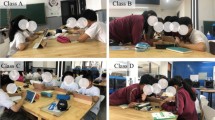Abstract
Within the context of Roger’s Diffusion of Innovation theory we propose a pedagogical framework for attributes that can significantly affect student adoption of collaborative learning environment like multi-user, multi-touch tabletop. We investigated the learning outcomes of secondary school students in India collaboratively using OLabs on a tabletop (EG1 = 30) vs. individually using at desktops (EG2 = 92). We analyzed the nature of communication, touch and non-touch gesture actions, position around the tabletop, focus group interviews, and pre and post test scores. Using Bass model the study also accounts for the inter influence of related group of potential adopter teachers who are likely to exert positive influence on students. The results revealed that learning outcomes on tabletop are strongly associated with innovation attributes like Relative Advantage, Compatibility, Ease of Use, Perceived Enjoyment, Perceived usefulness and Teachers support. Overall students expressed much more positive attitude to adopt tabletop technology for learning vs. desktop. We find that the mean group performance gain is significant with collaboration using tabletop and significantly greater than the group using desktops. We also find that the group interactions with the tabletop area significant factor that contributes to the group’s average performance gain. However, the total time spent in while using the tabletop is surprisingly not a significant factor in the performance gain. Our findings contribute to the design of new pedagogical models for science learning that maximizes the collaborative learning potential of tabletops.
Access this chapter
Tax calculation will be finalised at checkout
Purchases are for personal use only
Preview
Unable to display preview. Download preview PDF.
Similar content being viewed by others
References
Bass, F.M.: A new product growth for model consumer durables. Management Science 15, 215–227 (1969)
CBSE 2006 Assessment of Practical Skills in Science and Technology, Central Board of Secondary Education, India (2006)
Hatch, A., Higgins, S., Mercier, E.: SynergyNet: Supporting Collaborative Learning in an Immersive Environment. In: STELLAR Alpine Rendez-Vous Workshop 2009: “Tabletops for Education and Training”, Garmisch–Partenkirchen (2009)
Karmeshu, Pathria, R.K.: Stochastic Evolution of a Nonlinear Model of Diffusion of Information. Journal of Mathematical Sociology 7, 59–71 (1980)
Khandelwal, M., Mazalek, A.: Teaching Table: A tangible mentor for pre-K math education. In: Proceedings of the First International Conference on Tangible and Embedded Interaction, pp. 191–194. ACM Press (2007)
Nedungadi, P., Raman, R.: Effectiveness of adaptive learning with interactive animations and simulations. In: 3rd International Conference on Advanced Computer Theory and Engineering (ICACTE), August 20-22, vol. 6, pp. V6-40–V6-44 (2010)
Nedungadi, P., Raman, R.: Learning-Enabled Computer Assessment of Science Labs with Scaffolds Methodology. The Technology Interface International Journal | 11(2) (Fall/Winter 2011)
Rick, J.: Quadratic: Manipulating algebraic expressions on an interactive tabletop. In: Proceedings of IDC 2010, pp. 304–307. ACM Press, New York (2010)
Rogers, E.M.: Diffusion of Innovations, 5th edn. Free Press, New York (2003)
Do-Lenh, S., Jermann, P., Cuendet, S., Zufferey, G., Dillenbourg, P.: Task Performance vs. Learning Outcomes: A Study of a Tangible User Interface in the Classroom. In: Wolpers, M., Kirschner, P.A., Scheffel, M., Lindstaedt, S., Dimitrova, V. (eds.) EC-TEL 2010. LNCS, vol. 6383, pp. 78–92. Springer, Heidelberg (2010)
Surry, D.W., Farquhar, J.D.: Diffusion theory and instructional technology. Journal of Instructional Science and Technology (1997)
Author information
Authors and Affiliations
Editor information
Editors and Affiliations
Rights and permissions
Copyright information
© 2014 Springer International Publishing Switzerland
About this paper
Cite this paper
Raman, R., Nedungadi, P., Ramesh, M. (2014). Modeling Diffusion of Tabletop for Collaborative Learning Using Interactive Science Lab Simulations. In: Natarajan, R. (eds) Distributed Computing and Internet Technology. ICDCIT 2014. Lecture Notes in Computer Science, vol 8337. Springer, Cham. https://doi.org/10.1007/978-3-319-04483-5_34
Download citation
DOI: https://doi.org/10.1007/978-3-319-04483-5_34
Publisher Name: Springer, Cham
Print ISBN: 978-3-319-04482-8
Online ISBN: 978-3-319-04483-5
eBook Packages: Computer ScienceComputer Science (R0)




